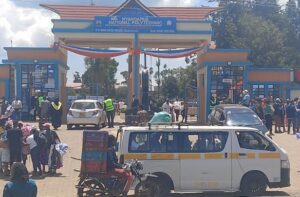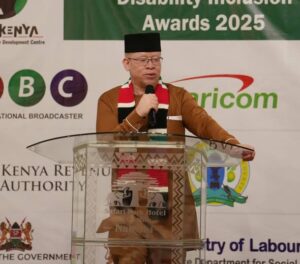North Rift Residents Back Wildlife Fee Proposal, Demand Sitatunga Protection and Return of Giraffes
“revenue from the revised fees would be reinvested into anti-poaching operations, habitat restoration, human-wildlife conflict mitigation”,KWS Senior Assistant Director for the Central Rift Region Gedion Kebati.

KWS Senior Assistant Director Gedion Kebati addresses the media in Eldoret during a public forum on the proposed 2025 Wildlife Conservation and Management fee regulations.
The proposed Wildlife Conservation and Management (Access and Conservation) Fees Regulation 2025 received strong public backing from residents of the North Rift during a public participation forum held at the Eldoret Town Hall on Friday. The regulation, drafted by the Kenya Wildlife Service (KWS), seeks to review park and reserve entry fees, which have remained unchanged for nearly a decade.
If approved by Parliament, the new structure will see entry fees to national parks and reserves adjusted to reflect current ecological and economic realities. According to KWS Senior Assistant Director for the Central Rift Region Gedion Kebati, the review aims to address a Sh10 billion annual funding shortfall that threatens Kenya’s wildlife conservation efforts.
“We are engaging members of the public to build consensus on a new fee structure that supports conservation goals without burdening communities,” said Kebati. “The last review was nearly two decades ago, yet operating costs and ecological demands have significantly changed.”
Local Voices Support the Plan—and Push for Action
Among the strongest supporters of the proposal were local civil society organizations and environmental advocates. Philip Barno, who led a coalition of civil society groups at the forum, praised the proposed regulation, saying it would strengthen the capacity of KWS to conserve endangered species.
“This regulation is not just about park fees—it’s about protecting ecosystems and securing the future of threatened species like the sitatunga antelope, grey crowned crane, and various indigenous antelopes whose numbers are rapidly declining,” said Barno.
Barno and other participants urged the government to prioritize conservation efforts at King’wal Swamp in Nandi County, one of the few remaining habitats of the rare sitatunga, a semi-aquatic antelope that has become increasingly elusive due to habitat destruction and neglect.
“King’wal Swamp should be declared a protected sanctuary. The sitatunga population is dwindling, and we risk losing it completely without urgent intervention,” Barno warned.
Call to Return Giraffes to Uasin Gishu
In addition to sitatunga protection, residents demanded the return of giraffes that were previously relocated from Uasin Gishu County. Local leaders and conservationists argued that their absence has hurt the region’s biodiversity and tourism appeal.
“The giraffes were part of our heritage and local economy. We want them brought back and better managed, not just moved around without community consultation,” said Jane Cheptoo, a resident and eco-tourism advocate.
Suggestions for Accessibility
Stanley Kibet, another participant, called for the revised regulation to allow free entry for children aged 5 to 18 years, arguing that encouraging youth access to wildlife areas would cultivate a culture of conservation.
“Conservation starts with education. Let’s give our children access to these spaces early so they can understand and protect them in the future,” Kibet said.
Kebati assured attendees that all public feedback from forums across the country would be incorporated before finalizing the proposal.
“We are listening. The final framework will reflect the views of communities, conservationists, and tourism stakeholders alike,” he said.
Kebati added that revenue from the revised fees would be reinvested into anti-poaching operations, habitat restoration, human-wildlife conflict mitigation, and other core programs critical to sustaining Kenya’s natural heritage.





